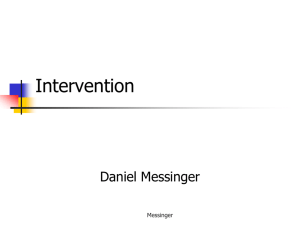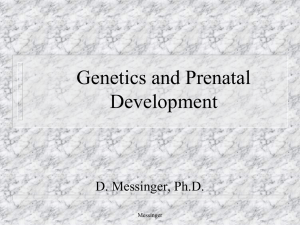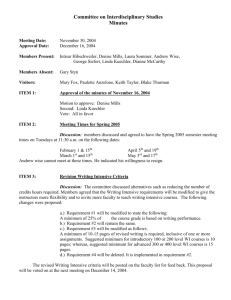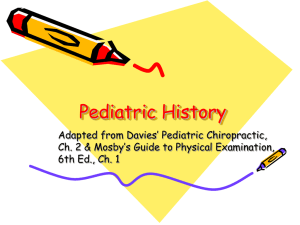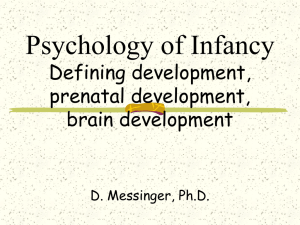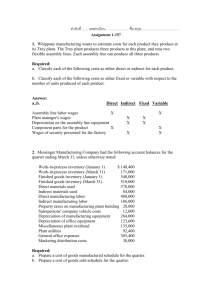Subjectivity
advertisement
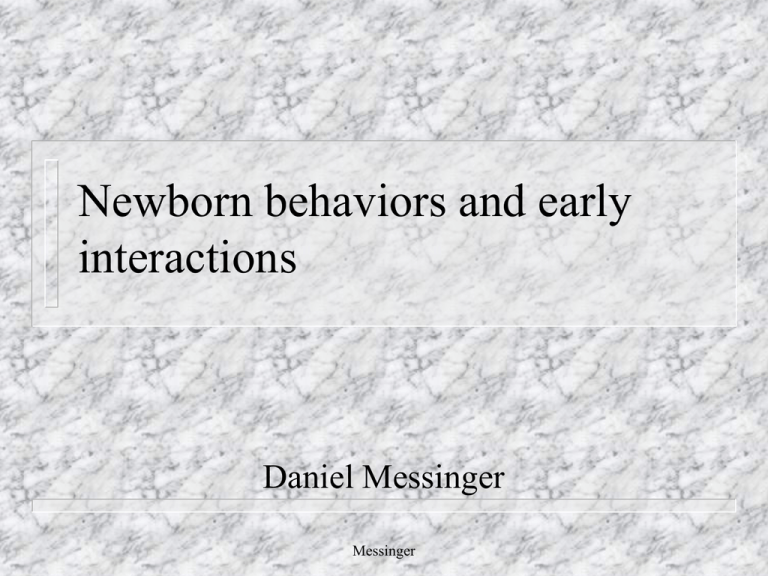
Newborn behaviors and early interactions Daniel Messinger Messinger Questions Neonate: What do studies of neonatal imitation indicate? Based on your observations, can neonatal macaques imitate? What form do neonatal smiles have? Are they due to gas? Are they a reflex? What is a reflex? What are advantages of breast-feeding? What issues are relevant to promoting breast-feeding? What is the central issue in investigating the effects of breast-feeding vs. bottle-feeding? How do infant and mother interact (influence each other) during feeding? How is this and how is it not interaction? [How do your observations of feeding relate to this topic?] Discuss the Brazelton exam and what it reveals about the individuality of neonates (give examples from film). Messinger Neonates are newborns Subjectivity Neonatal imitation - video Characteristics and capacities Evaluation of individuality through the Brazelton exam – – Neonatal smiling – film Reflexes video Feeding Messinger Neonates are Weak with limited motor capacities and self-regulatory capabilities – But an impressive array of reflexes and learning abilities that aid self-preservation Functional but immature sensory capacities Strident expressive abilities such as crying Engage in primitive interactions such as during feeding Messinger Subjectivity The baby, assailed by eyes, ears, nose, skin, and entrails at once. Feels that all is one great blooming buzzing confusion. William James, 1890 Some support: Enhanced neural intermingling newborn sensations “mixed together like a boulillabaisse” (Maurer & Maurer, 1988). Messinger Contemporary subjectivity Some multimodal comprehension – imitation Continuous, rapid integration Infant is always learning about, interacting with world. Messinger Neonatal imitation Infants between 12 and 21 days Imitation implies that human neonates can equate their own unseen behaviors with gestures they see others perform. ANDREW N. MELTZOFF 1 and M. KEITH MOORE 21 Messinger Monkey see, monkey do? Macaque imitation (Ferrari et al., 2006)? – day 1 “mouth openings elicited a similar matched behavior (lip smacking)”. confined to a narrow temporal window. Mouth opening: http://www.youtube.com/watch?v=k72WFYv6WMw Tongue protrusion: http://www.youtube.com/watch?v=-9k4Y8x-L6E Chimps imitate mouth opening (Bard, 2007) Debate: What exactly does infant do in response to exactly what stimulus? Human example: http://www.youtube.com/watch?v=k2YdkQ1G5QI&NR=1 Messinger What does it mean? Amodal ability Means to explore world Why does it disappear? Messinger Neonatal Smiling: A Developmental Puzzle Messinger et al., 2002; Dondi et al., 2007 Messinger What’s known Endogenous smiles while asleep (REM) Not more frequent after feeding – Not gas More smiling in premature infants Smiling in microcephalic infant – Suggests neonatal smiling is subcortical Nothing is known about how neonates smile – type of smile Messinger Duchenne > open-mouth smiles Half of smiles are Duchenne, suggests joy – 52% of neonates, .21 times per minute Few open mouth smiles (which suggest social arousal), 8%, .02 times per minute Messinger Smiling issues Are babies feeling joy (but not much arousal) or is this a muscular synergy? Why does smiling disappear after the neonatal period and before social smiling? Neonates smile in non-sleep states, but not as frequently. Naïve observers perceive neonatal smiles at less than half the rate of coders. Video Messinger Altricial-------------------Precocial altricial - young are relatively immobile, lack hair, require adult care; Precocial – mature sensory and motor apparatus, mobile What are humans? Messinger Tasks of the neonatal period Infant – – Energy conservation Gain body weight Born 7 ½ pounds, 20 inches long Parent – Coordinate schedule Sleep about sixteen hours a day Eat approximately every three hours In first year, most infants grow about ten inches Messinger Importance of feeding Young babies must conserve energy But sucking serves nutrition So they will suck to produce interesting stimuli – before they will kick to produce the same stimuli Messinger Time feeding decreases with age Messinger Nursing Period (0 - 6 months) Who breast feeds? – – – 50 - 60% of mothers Highest among college educated, high-income mothers above 30 Lowest among young , less educated, black, Hispanic, economically disadvantaged MLS – Resources (La Leche League, J. of H. Lact.) Messinger Breast-feeding Advantages Human milk - the nutritional standard – – – – Sterile (vs. formula use in underdeveloped countries) Confers antibodies to baby Lactose (from milk) is the primary carbohydrate in the young infant’s diet. Too little protein - restricted growth. For mother, breastfeeding promotes – uterine contraction Messinger Bottle feeding is ok Harder to breast-feed when working Formula provides what’s needed for healthy growth Normal growth - the best index of good nutrition Messinger Breastfeeding: Long-term outcomes? Breastfed babies do better than bottle-fed babies and the longer they are breastfed, the better they do - on various measures of cognitive achievement and outcome – – – WISC intelligence at 8 and 9 years of age Math and reading from 8 to 12 years High school attainment exams at 15 & 16 • L. John Horwood and David M. Fergusson (1998). Breastfeeding and Later Cognitive and Academic Outcomes. Pediatrics, 101 (1), e9 Messinger Other factors may be responsible Breastfed babies have other advantages – – – – Better educated mothers More well to-do familes Mothers less likely to smoke Infants a little heavier at birth Messinger But . . Breasteeding is still associated with positive outcomes after statistically controlling for other factors What might be producing the breastfeeding effect? Messinger Infant sucking – a specialized process Gums make the seal – Lower jaw drops to create negative pressure – Not by by breathing in Tongue expresses milk from back of nipple to front – Not lips Which is why young infants expel solids Which triggers swallowing Messinger Feeding is interaction Bi-directional – Each partner influences the other Infant: can continue suck or pause sucking Mother: can jiggle or not jiggle nipple Forerunner of face-to-face interaction and conversational turn-taking? Messinger Bi-directional detail Baby pauses elicit mom jiggling nipple – should be rare when the baby is sucking If jiggle continues, infant least likely to suck If there is no jiggle, intermediate likelihood of sucking If jiggle-then-stop, infant is most likely to suck – – Experimental data show the jiggle must be brief Mothers shorten duration of jiggles in 1st 2 weeks Messinger Moms influence on baby Mothers are inserting jiggles in cycles of infant sucks and pauses So infant would start sucking even if mom did not jiggle But jiggling and then stopping jiggling does encourage suck Messinger Psychology of early feeding Early anaclitic model – interaction depends on nourishment Current interactive view – – – Breast or bottle doesn’t matter for interaction Reading baby’s cues Interactive process Messinger Paired concepts from Video Mother and infant Interaction and feeding Sensitivity and matter-of-factness Quantitative and qualitative measures Messinger Sensory system development Messinger Sensory capacity Smell – Turn down the corners of their mouths to bad smells, such as rotten eggs – Facial relaxation to sweet smells like chocolate Taste is similar – Discriminate bitter, neutral, and sweet (Oster) – Prefer sweet tastes to all others Evolutionary advantages Messinger Sensory capacity: Vision Vision is functional from birth But acuity is 1/25 that of adults – 20:500, – blurry but in color Improves to 20:20 by six months Messinger Auditory Abilities: Hearing 40-50 Db. Not 10 Sound localization is good Detect one note differences Messinger Reflexes Definition: A given stimuli produces a stereotypic response – Relatively invariant Is smiling a reflex? Spinal cord control: Present in anencephaly – Primitive reflexes Sucking and grasping Messinger Reflex functionality Survival and protection – Sucking – Grasping (evolutionary environment) – Habituation Development – Bases for later action – Sucking (Piaget) But also drop out Messinger Brazelton Scale (NBAS) Assesses Four Dimensions of Infant Behavior – – – – Motor Behavior and Reflexes Physiological Control Response to Stress Interactive Behaviors Messinger Integrated into a Behavioral "portrait" of the infant, describing the baby's strengths, individuality, adaptive responses and possible vulnerabilities. These individual differences are used for different purposes – – – Clinical (neurological) Research Parent education Messinger Behavior depends on state Links input and output – – Though babies can influence behavioral state through their activities Self-regulating Messinger Simplified system (1) Sleeping; eyes closed throughout feeding session. (2) Drowsy; eyes may be open but dull and heavy lidded, eyelids fluttering, Gaze does not shift, baby may stare. (3) Alert: eyes opened, seems to focus on the caretaker or bottle. (4) Fussy/crying; whimpering or crying during food. Messinger Most time sleeping Messinger Mean duration of waking increases Messinger Brazelton exam overview Individual differences Best performance State as baseline for behavior Examiner changes behavior Allowing infants to express individual differences in self-comforting, attentiveness, state-regulation, etc. Video Messinger Grasping reflex Stimulation: Palm of baby’s hand is stroked Behavior: Baby makes strong fist; can be raised to standing position if both fists are closed around a stick. Approx. Age of dropping out: 2 months Messinger Walking Stimulation: Baby is held with bare feet touching flat surface Behavior: Baby makes step-like motions that look like well-coordinated walking Approx. Age of dropping out: 2 months – – Why does it drop out? Under what circumstances can it be seen even – after two months What does this tell us about developmental process? Messinger Moro (startle) Stimulation: Baby is dropped or hear loud noise Behavior: Baby extends legs, arms, and fingers; arches back; draw back head. Approx. Age of dropping out: 3 months Messinger Babinski Stimulation: Sole of baby’s foot is stroked Behavior: Baby’s toes fan out; foot twists in Approx. Age of dropping out: 6-9 months Messinger Additional neonate readings Brazelton et al. on neonatal individuality Lester et al. on neonatal individuality through differences in pain cries Can neonates imitate? (Meltzoff et al.) Causes and consequences of imitation. By Heyes, C. Trends in Cognitive Sciences. 2001 Jun Vol 5(6) 253-261 No compelling evidence that newborns imitate oral gestures. Anisfeld, M; Turkewitz, G; Rose, SA.; Rosenberg, F R.; Sheiber, F J.; Couturier-Fagan, D A.; Ger, J S.; Sommer, Infancy. 2001 Vol 2(1) 111-122 – Colic as an individual difference that does not predict Multimodal perception studies Wolff Messinger Additional Feeding Readings L. John Horwood and David M. Fergusson (1998). Breastfeeding and Later Cognitive and Academic Outcomes. Pediatrics, 101 (1), e9 Kaye & Wells (1980). Rovee-Collier and the energy budget Messinger Heart rate – classic orienting index Messinger Heart rate variability vagal tone index of optimal functioning Messinger
